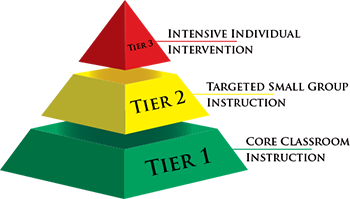Riverside County Office of Education
Home MenuPositive Behavior Interventions and Support (PBIS)
Positive Behavioral Interventions and Supports (PBIS) is an evidence-based three-tiered framework for improving and integrating all of the data, systems, and practices affecting student outcomes every day.
PBIS is a layered framework of delivery that increases the duration, intensity and/or frequency of behavioral instruction and support based on stakeholder response, strengths and needs. Emphasis is placed on teaching and reinforcing important social skills and data-based problem-solving to address existing behavior concerns.
PBIS as a Multi-Tiered Framework for Behavior
A Multi-Tiered System of Support (MTSS) is a data-driven, problem-solving framework to improve outcomes for all students. MTSS relies on a continuum of evidence-based practices matched to student needs. PBIS is an example of MTSS centered on social behavior.
 Three Tiers of Support
Three Tiers of Support
MTSS emerged as a framework from the work conducted in public health emphasizing three tiers of prevention. Schools apply this model as a way to align to academic, behavioral, social, and emotional supports to improve education for all students. It’s important to remember these tiers refer to levels of support students receive, not to students themselves. Students receive Tier 2 supports, they are not Tier 2 students.
Tier 1: Universal Prevention (All)
Tier 1 supports serve as the foundation for behavior and academics. Schools provide these universal supports to all students. For most students, the core program gives them what they need to be successful and to prevent future problems.
Tier 2: Targeted Prevention (Some)
This level of support focuses on improving specific skill deficits students have. Schools often provide Tier 2 supports to groups of students with similar targeted needs. Providing support to a group of students provides more opportunities for practice and feedback while keeping the intervention maximally efficient. Students may need some assessment to identify whether they need this level of support and which skills to address. Tier 2 supports help students develop the skills they need to benefit core programs at the school.
Tier 3: Intensive, Individualized Prevention (Few)
Tier 3 supports are the most intensive supports the school offers. These supports require are the most resource intensive due to the individualized approach of developing and carrying out interventions. At this level, schools typically rely on formal assessments to determine a student’s need and to develop an individualized support plan. Student plans often include goals related to both academics as well as behavior support.
Key Components at Every Tier
Each tier has its own set of systems and practices, but some key components appear across every level. Each of these features needs to be present in order for MTSS to be implemented with fidelity.
- Practices are based on evidence to be effective in a similar context with similar populations.
- Practices are organized along a tiered continuum beginning with strong universal supports followed by intensified interventions matched to student needs.
- Data are collected and used to screen, monitor, and assess student progress.
- Resources are allocated to ensure systems and practices are implemented with fidelity over time.
